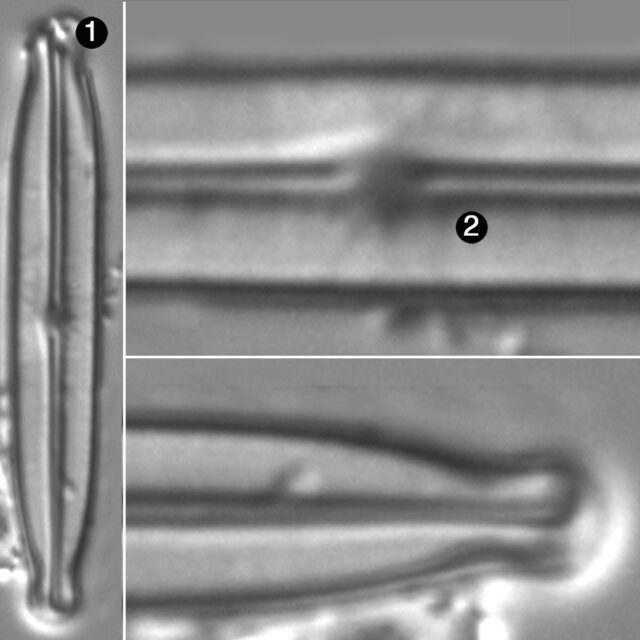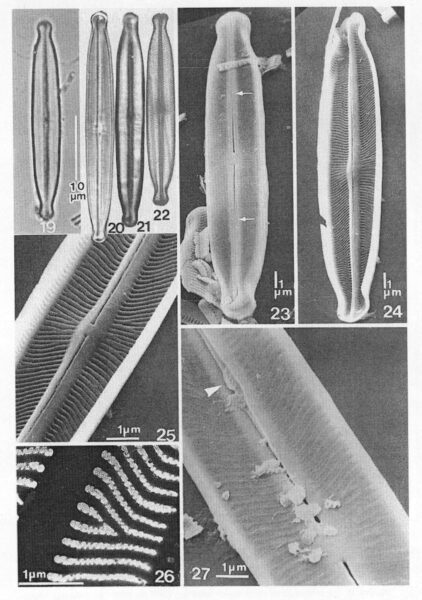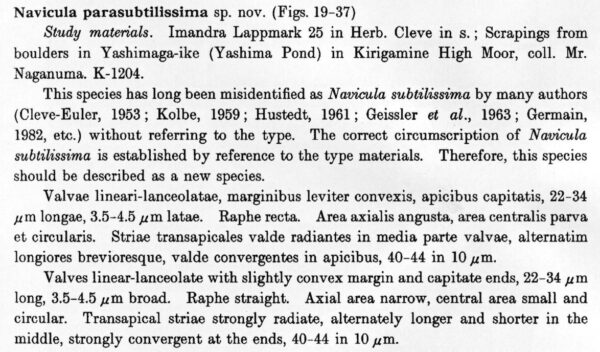
Kobayasiella parasubtilissima
-
Category
-
Length Range25-42 µm
-
Width Range4.0-4.7 µm
-
Striae in 10 µmcannot be resolved in LM
-
SynonymsKobayasia parasubtilissima (H.Kobayasi and Nagumo) Lange-Bert. 1996
-
Reported AsNavicula subtilissima (Kramer and Lange-Bertalot 1986, pg. 182, Fig. 79: 22-26)
Navicula parasubtilissima (Camburn and Charles 2000, pg. 24, plate 34, fig. 5)
-
ContributorLoren Bahls - Mar 2012
-
ReviewerRex Lowe - Oct 2012
Identification
Description
Valves are linear-lanceolate with convex margins and short, capitate apices. Length-to-width ratio ranges from 6.0 to 9.3. The raphe is filiform and straight. Proximal raphe ends are weakly expanded. Distal raphe ends are bent in the same direction. The axial area is narrow. The central area is elliptic and barely wider than the axial area. Individual striae difficult to resolve in LM but appear to be more radiate at the valve center.
Autecology
Kobayasiella parasubtilissima occurs in four weakly acid to somewhat alkaline fens in the Northern Rocky Mountains, where the pH range is 5.50 to 8.46 and the specific conductance range is 19 to 257 µS/cm. At Drosera Pond on the Indian Meadows Research Natural Area in Montana, K. parasubtilissima is found in association with K. okadae, K. micropunctata, and K. subtilissima.
-
Size Range, µm3
-
Motility
-
Attachment
-
Habitat
-
Colony
-
Waterbody
- Learn more about this

Credit: Loren Bahls
Drosera Pond on the Indian Meadows Research Natural Area, Helena National Forest, Montana. Drosera Pond is a floating-mat fen with a central pool of open water. Besides four species of Kobayasiella and several other rare diatom taxa, Drosera Pond supports three imperiled species of vascular plants.
Original Description
Valves linear-lanceolate with slightly convex margin and capitate ends, 22-34 µm long, 3.5-4.5 µm broad. Raphe straight. Axial area narrow, central area small and circular. Transapical striae strongly radiate, alternately longer and shorter in the middle, strongly convergent at the ends, 40-44 in 10 µm.
-
BasionymNavicula parasubtilissima
-
AuthorH.Kobayasi and Nagumo 1988
-
Length Range22-34 µm
-
Width3.5-4.5 µm
-
Striae in 10µm40-44
Citations & Links
Citations
Links
-
Index Nominum Algarum
Cite This Page
Bahls, L. (2012). Kobayasiella parasubtilissima. In Diatoms of North America. Retrieved April 26, 2024, from https://diatoms.org/species/kobayasiella_parasubtilissima
Responses
The 15 response plots show an environmental variable (x axis) against the relative abundance (y axis) of Kobayasiella parasubtilissima from all the stream reaches where it was present. Note that the relative abundance scale is the same on each plot. Explanation of each environmental variable and units are as follows:
ELEVATION = stream reach elevation (meters)
STRAHLER = distribution plot of the Strahler Stream Order
SLOPE = stream reach gradient (degrees)
W1_HALL = an index that is a measure of streamside (riparian) human activity that ranges from 0 - 10, with a value of 0 indicating of minimal disturbance to a value of 10 indicating severe disturbance.
PHSTVL = pH measured in a sealed syringe sample (pH units)
log_COND = log concentration of specific conductivity (µS/cm)
log_PTL = log concentration of total phosphorus (µg/L)
log_NO3 = log concentration of nitrate (µeq/L)
log_DOC = log concentration of dissolved organic carbon (mg/L)
log_SIO2 = log concentration of silicon (mg/L)
log_NA = log concentration of sodium (µeq/L)
log_HCO3 = log concentration of the bicarbonate ion (µeq/L)
EMBED = percent of the stream substrate that is embedded by sand and fine sediment
log_TURBIDITY = log of turbidity, a measure of cloudiness of water, in nephelometric turbidity units (NTU).
DISTOT = an index of total human disturbance in the watershed that ranges from 1 - 100, with a value of 0 indicating of minimal disturbance to a value of 100 indicating severe disturbance.

Kobayasiella parasubtilissima
- Valves narrow
- Striae difficult to resolve
- Valve length-to-width ratio 6.0-9.3
Valves are narrow, 4.0-4.7 µm wide. The length to width ratio is 6.0-9.3. Striae are difficult to resolve, but appear to be radiate at the center.
 Diatoms of North America
Diatoms of North America






